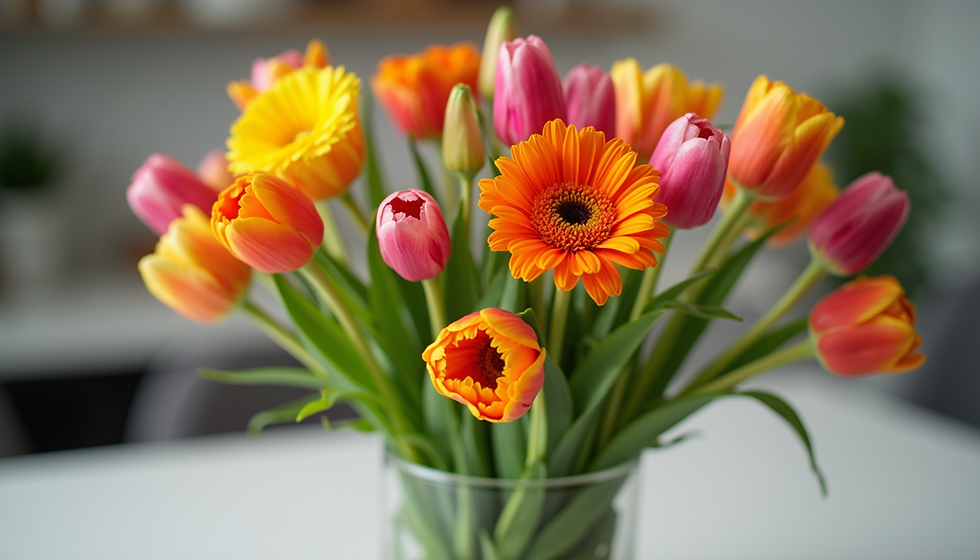The Timeless Art of Flower Arranging: A Journey Through History
- Blossom & Cloth

- Jul 24
- 4 min read
Flower arranging, an art form that transforms blooms into breathtaking displays, has a rich history spanning cultures and centuries. From ancient rituals to modern-day aesthetics, the practice of arranging flowers has evolved, reflecting human creativity, cultural values, and the beauty of nature. Let’s explore the fascinating history of floral design and how it continues to captivate us today.

Ancient Beginnings: Flowers in Ritual and Symbolism
The origins of flower arranging can be traced back to ancient civilizations, where flowers held deep symbolic meaning. In Ancient Egypt (circa 2800 BCE), floral arrangements were used in religious ceremonies and burials. Lotus flowers, symbolizing rebirth, were meticulously arranged in vases or scattered in tombs to honor the deceased. These early arrangements were simple but purposeful, emphasizing symmetry and natural beauty.
In Ancient China, during the Han Dynasty (206 BCE–220 CE), flower arranging began to emerge as an art form. Influenced by Confucian and Taoist philosophies, arrangements focused on harmony and balance, often incorporating seasonal blooms to reflect the cycles of nature. The Chinese valued simplicity, with sparse yet deliberate placements of flowers like peonies and chrysanthemums.
Meanwhile, in Ancient Greece and Rome, flowers were woven into garlands and wreaths for festivals, weddings, and religious offerings. Roses, violets, and laurel leaves were popular, symbolizing love, victory, or divine favor. These arrangements were less about vases and more about wearable or decorative displays, showcasing the vibrancy of Mediterranean flora.
The Middle Ages: Sacred and Subtle
During the Middle Ages (5th–15th centuries), flower arranging in Europe took on a sacred tone. Monasteries and churches used flowers to adorn altars, with arrangements reflecting Christian symbolism. Lilies, representing purity, and roses, symbolizing divine love, were common. However, floral design remained understated due to the era’s focus on spirituality over ornamentation.
In contrast, the Byzantine Empire saw more opulent arrangements, with intricate mosaics and tapestries depicting flowers in vibrant patterns. This influence spread to Islamic art, where floral motifs flourished in gardens and decorative arts, though cut-flower arrangements were less common due to cultural preferences for living plants.
The Renaissance and Beyond: A Flourish of Creativity
The Renaissance (14th–17th centuries) marked a turning point for flower arranging in Europe. As art and humanism flourished, so did an appreciation for natural beauty. Wealthy households displayed lavish bouquets in ornate vases, often featuring exotic blooms like tulips, introduced from the Ottoman Empire. The Dutch and Flemish masters immortalized these arrangements in still-life paintings, showcasing the opulence of the era’s floral designs.
In Japan, the art of Ikebana emerged during this period, rooted in Buddhist traditions. Originating in the 7th century as offerings in temples, Ikebana evolved into a disciplined art form by the 15th century. Unlike Western arrangements, Ikebana emphasizes minimalism, asymmetry, and the spiritual connection between the arranger, the flowers, and the environment. Each stem is carefully placed to represent heaven, earth, and humanity.
The Victorian Era: A Language of Flowers
The Victorian era (1837–1901) brought flower arranging into the mainstream in Europe and America. The concept of floriography, or the language of flowers, became wildly popular. Every bloom carried a specific meaning—roses for love, violets for modesty, and forget-me-nots for remembrance. Arrangements became a way to convey emotions and messages, especially in courtship.
Victorian arrangements were lush and elaborate, often displayed in parlors or at social events. Innovations like the nosegay (small handheld bouquets) and the introduction of glasshouses allowed for year-round access to exotic flowers, fueling creativity. Florists began to emerge as professionals, catering to the growing demand for intricate designs.
The Modern Era: Fusion and Innovation
The 20th century saw flower arranging become a global art form, blending traditions from East and West. In the United States, the rise of floral design schools and organizations like the American Institute of Floral Designers (AIFD) professionalized the craft. Designers like Constance Spry in the UK revolutionized the field by incorporating unconventional elements like foliage, berries, and even vegetables into arrangements, breaking away from rigid Victorian styles.
Today, floral design is a dynamic blend of tradition and innovation. Modern arrangers draw inspiration from Ikebana’s minimalism, Victorian symbolism, and contemporary trends like sustainable floristry. Foam-free designs, locally sourced blooms, and eco-conscious practices reflect a growing awareness of environmental impact. Social media platforms like Instagram have also transformed the industry, showcasing vibrant, trendsetting arrangements to a global audience.
Why Flower Arranging Endures
The history of flower arranging is a testament to humanity’s enduring love for nature’s beauty. From ancient rituals to modern masterpieces, floral design has always been about more than aesthetics—it’s a way to connect with culture, express emotions, and celebrate life’s moments. Whether you’re creating a simple bouquet or an elaborate centerpiece, the art of arranging flowers invites us to pause, appreciate, and create something beautiful.
At Blossom & Cloth, we’re inspired by this rich history as we craft arrangements that tell your unique story. Ready to bring a touch of timeless beauty to your next event? Contact us today to explore our custom floral designs!




Comments